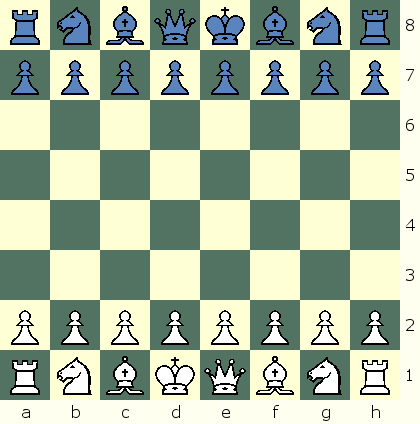Basic chess rules are essential if you want to learn chess. That’s why we are explaining these chess rules in an easy to understand way. From initial board set up to movement of every piece, we will explain everything in this chess rules section.
History of chess
Chess is believed to have been invented 1500 years ago in India. The game has changed only slightly since then with the advent of the queen in the 15th century and some minor movement adjustments in the 1800s.
Chess game goal
The ultimate aim in the chess game is delivering a checkmate – trapping your opponent´s king. The term checkmate is an alteration of the Persian phrase “Shah Mat”, meaning literally, “the King is ambushed”, and not “the King is dead”, that is a common misconception.
General Chess Rules
White is always first to move and players take turns alternately moving one piece at a time. Movement is required. If a player´s turn is to move, he is not in check but has no legal moves, this situation is called “Stalemate” and it ends the game in a draw.
Each type of piece has its own method of movement. A piece may be moved to another position or may capture an opponent´s piece, replacing on its square (en passant being the only exception). With the exception of the knight, a piece may not move over or through any of the other pieces.
When a king is threatened with capture (but can protect himself or escape), it´s called check. If a king is in check, then the player must make a move that eliminates the threat of capture and cannot leave the king in check.
Checkmate happens when a king is placed in check and there is no legal move to escape. Checkmate ends the game and the side whose king was checkmated looses. Chess for kids would be a great option to help the kid enhance his thinking capability with the chess strategies involved.
The initial position setup
The chessboard is made up of eight rows and eight columns for a total of 64 squares of alternating colors. Each square of the chessboard is identified with a unique pair of a letter and a number. The vertical files are labeled a through h, from White´s left (i.e. the queenside) to White´s right. Similarly, the horizontal ranks are numbered from 1 to 8, starting from the one nearest White´s side of the board. Each square of the board, then, is uniquely identified by its file letter and rank number.
In the initial position setup, the light queen is positioned on a light square and the dark queen is situated on a dark square.
The diagram below shows how the pieces should be initially situated.

Chess moves
King can move exactly one square horizontally, vertically, or diagonally. At most once in every game, each king is allowed to make a special move, known as castling.
Queen can move any number of vacant squares diagonally, horizontally, or vertically.
Rook can move any number of vacant squares vertically or horizontally. It also is moved while castling.
Bishop can move any number of vacant squares in any diagonal direction.
Knight can move one square along any rank or file and then at an angle. The knight´s movement can also be viewed as an “L” or “7″ laid out at any horizontal or vertical angle.
Pawns can move forward one square, if that square is unoccupied. If it has not yet moved, the pawn has the option of moving two squares forward provided both squares in front of the pawn are unoccupied. A pawn cannot move backward. Pawns are the only pieces that capture differently from how they move. They can capture an enemy piece on either of the two spaces adjacent to the space in front of them (i.e., the two squares diagonally in front of them) but cannot move to these spaces if they are vacant. The pawn is also involved in the two special moves en passant and promotion.
Comments